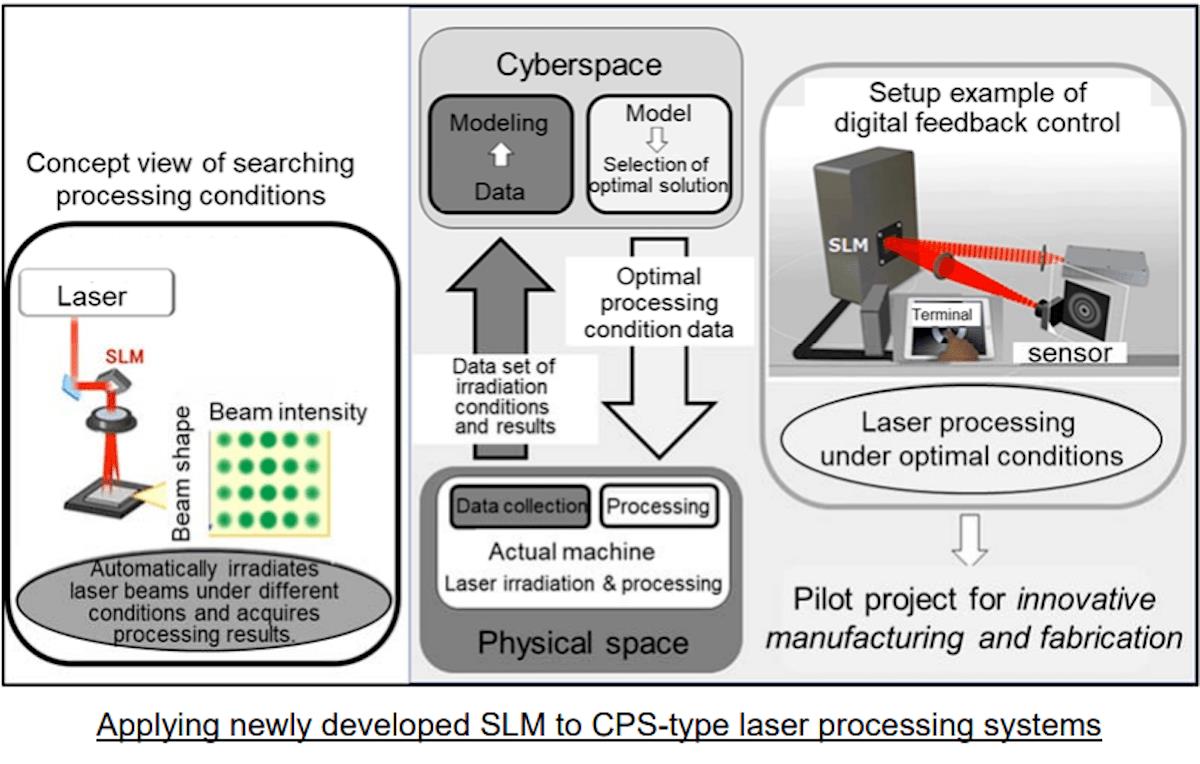
Japan Becomes Global Contender In Industrial Lasers
More than 20 companies are active in the field of ultrashort pulse (USP) lasers worldwide, according to Laser Focus World,. Most of them are European and American; a few are from China.
Now there is a new, potentially powerful Japanese entrant.
Hamamatsu Photonics is enlisting European support to expand its laser-related product line and develop industrial laser technology that“can process virtually any material at the highest precision.”
This claim is made by the Japanese company and Germany's Fraunhofer Institute for Laser Technology as they announce the establishment of a jointly-run laboratory in Aachen to develop applications for ultrashort pulsed (USP) lasers using Hamamatsu's new, high-power spatial light modulator (SLM).
The establishment of the lab in Aachen follows preparatory work on the technology by the two partners and the announcement, on June 24, of Hamamatsu Photonics' acquisition of NKT Photonics, a Danish laser maker that has“unique photonic crystal fiber production technology for USP laser amplification and fiber transmission.” Pending regulatory approval, the deal should be completed at the end of March 2023.
Hamamatsu Photonics, headquartered in Shizuoka Prefecture, Japan, is perhaps best known for its work with Nobel Prize winner Masatoshi Koshiba, which led to the construction of the Kamiokande neutrino detector in Gifu Prefecture (see“Nobel laureate physicist Masatoshi Koshiba dies at 94” (Asia Times, November 16, 2020).

Nobel laureate Masatoshi Koshiba. Photo: Facebook
In addition to its near total dominance of the global market for photomultiplier tubes (which are used to detect the neutrinos, among numerous other applications), Hamamatsu Photonics is a leading producer of laser diodes, optical sensors and components, light and radiation sources, specialty cameras and other imaging and measurement instruments.
Its products are used worldwide in medical diagnostics, semiconductor inspection and wafer dicing, non-destructive testing and factory automation, high-energy physics, food inspection, water-quality analysis and other applications, including those acquired via NKT Photonics and the Fraunhofer Institute for Laser Technology.
The Institute, located in Aachen, is a contract R&D organization that develops new production processes and components together with customers from the automotive, aircraft, mechanical and electrical engineering, medical, optical and other industries, including laser manufacturing and measurement start-ups. One of 76 institutes and research facilities operated by Fraunhofer-Gesellschaft, it has nearly 500 employees and has generated more that 40 spin-offs.
According to its website, the Institute has expertise in a broad range of advanced technologies, including lasers, optical systems, quantum technology, laser measurement technology, additive manufacturing, surface technology, cutting, digitalization, EUV (extreme ultraviolet) and plasma technology, and medical technology.
The Fraunhofer-Gesellschaft, headquartered in Munich, advertises itself as“the world's leading applied research organization.” Operating almost worldwide, it consists of nine groups: energy and climat, health, information and communications, innovation, light and surfaces, materials and components, microelectronics, production, and resource technologies and bioeconomy. Its goal is to prioritize“key future-related technologies” and commercialize its findings in business and industry. It has about 30,000 employees, most of them scientists and engineers.
Specialists from Hamamatsu and Fraunhofer have already developed“an industrial processing SLM-head that can use customized, dynamic beam shaping combined with large laser average output powers for a wide range of applications,” their press release says.“SLMs are particularly suitable for developing manufacturing processes that use USP laser radiation since the beam properties can be easily adapted and tailored.”

Hamamatsu's new, high-power spatial light modulator. Image: Hamamatsu Photonics
As explained by German photonics company Holoeye, spatial light modulators are devices that modulate the amplitude, phase or polarization of light waves in space and time. They are used in display, holography, laser beam shaping, laser pulse modulation, optical metrology and other applications, including laser material processing.
Processes employing USP lasers include micro-machining, ablation, surface finishing, cutting, scribing and drilling. They are particularly good for processing brittle or fragile materials – for precise cutting of thin glass, as one example.
Hamamatsu Photonics received funding for the new lab under the Cross-ministerial Strategic Innovation Promotion Program led by the Japanese government's Council for Science, Technology and Innovation. The program promotes interdisciplinary R&D from fundamental research to industrial application with the cooperation of industry, academia and government.
As for the acquisition of NKT Photonics, its products include:
- Supercontinuum white-light lasers, which are used as light sources in microscopy and semiconductor inspection;
- Single-frequency fiber lasers, which are used to form ion and atom cold traps in quantum computing, sensing and other applications;
- Ultrafast fiber Lasers, now used as surgical lasers in ophthalmology and expected to be used in semiconductor wafer dicing and high-precision industrial processing.
These products complement the existing line-up of Hamamatsu Photonics. Substantial new product development and marketing synergies are expected. NKT Photonics' management, staff, facilities and branding reportedly will be retained.
The Danish company, after two years of losses and the sale of its non-core sensing business last March, looks forward to continuing operations with sound financial support as a wholly-owned subsidiary of Hamamatsu Photonics. The 205 million euro acquisition price (¥28.7 billion at the current exchange rate) is easily covered by net cash of 775 million euros (¥108.5 billion) on Hamamatsu Photonics' balance sheet at the end of June.
NKT Photonics currently generates annual sales of about 70 million euros (about ¥10 billion). This is equivalent to about 5% of Hamamatsu Photonics' total consolidated sales and 15% of its industrial instrument sales.
All of this should be considered before jumping to conclusions about China taking over global manufacturing.
Follow this writer on Twitter: @ScottFo83517667

Legal Disclaimer:
MENAFN provides the
information “as is” without warranty of any kind. We do not accept
any responsibility or liability for the accuracy, content, images,
videos, licenses, completeness, legality, or reliability of the information
contained in this article. If you have any complaints or copyright
issues related to this article, kindly contact the provider above.


















Comments
No comment